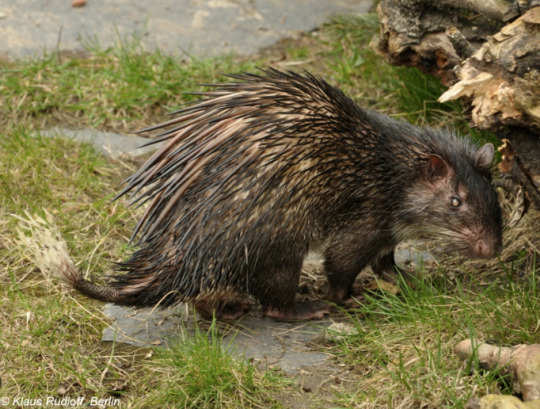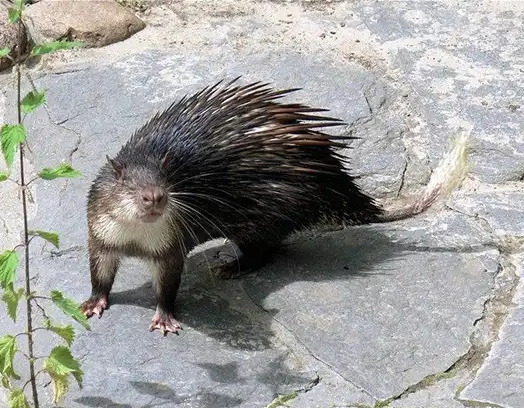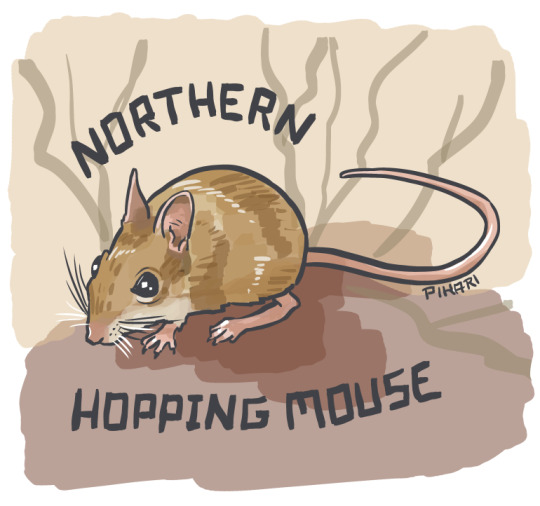#rodent species
Explore tagged Tumblr posts
Text
7th of October 2024: Celebes Rat

Let us explore the Indonesian forest by briefly checking out the Celebes Rat (Taeromys celebensis), also known as the Long-tailed Taeromys. They are found on Sulawesi, though their presence in certain parts of the island appears to be only historical, based upon fossils found there [1].
They appear to be very different than many of the other species in their genus. The prime example is that they’re arboreal while the other Taeromys are terrestrial. This also leads to them having a far longer tail than them [1]. Their body is already around 20 to 25 cm long, and their tail can add up to 30 cm to that [2].
They are considered very easy to trap, and is thus also found more easily than other Taeromys [3]. If you want to see them yourself you do have to go out at night though, as they are nocturnal [2] and even then it might be hard to spot them [4]. There is no information on their social life, however we do know that they feed on fruit [2]. They may also fall victim to the bushmeat trade and habitat loss, but luckily their range appears to be large enough that their existence is not threatened by this [3].
Sources: [1] [2] [3] [4] [Image]
#critter of the day#rodent#rodent species#rat#rat species#rat facts#rodent facts#small mammal#animal species#zoology#animal#animal facts
4 notes
·
View notes
Text
youtube
Naked Mole Rats: Nature's Odd Resilience
Discover the secrets of the naked mole rat! These fascinating creatures can survive without oxygen for long periods. Uncover more about their unique abilities!
Check out my other videos here: Animal Kingdom Animal Facts Animal Education
#Helpful Tips#Wild Wow Facts#Naked mole rats#nature's odd resilience#animal adaptation#strange animals#underground creatures#resilient animals#unique mammals#rodent species#mole rat facts#animal biology#African mole rats#animal survival#unusual rodents#evolutionary biology#naked mole rat behavior#animal science#animal research#extreme longevity#aging in animals#mole rat colonies#eusocial mammals#animal resilience#underground ecosystems#mole rat habitat#extraordinary animals#youtube#animal behavior#fun animal facts
0 notes
Text
I love that I'm can always still find out about cool animals that I never knew existed. Like today I learned that brush-tailed porcupines exist and straight up look like giant rats with spines



#Wait I think the top 2 photos are the african species and bottom is the asiatic species#Before anyone goes there I Am Aware That Porcupines Are Rodents#These guys are just so sleek compared to most of their relatives
15K notes
·
View notes
Text

Submitted for classification by @stevethe-intern
"This is Megatron my not so lil hamster"
#hamster#(not sure on specific species)#rodent#mammal#submission#megatron#monday poll#i used to tag names like this like “megatron (hamster)”#but now i think#if the hamster shows up in the tag for the transformers guy. so be it
83 notes
·
View notes
Text
This is a really exciting development! We've already seen the positive effects of beavers returning to their historic range here in North America, so it's even better to see the same thing underway across the Atlantic. A single pair with their first litter of kits certainly isn't a large-scale reintroduction, but it's proof that these animals have the capacity to get back to work here.
Beavers are often called ecosystem engineers, and for good reason. These keystone species alter waterways by building dams and lodges, creating ponds and other aquatic habitats for species that can't handle faster-moving water. These also often serve as water reservoirs during summer droughts. The dams and lodges themselves may also provide nesting sites for birds and shelter for other animals, plants, and fungi.
Sadly there are still people who want to see beavers trapped and hunted as pests because their dams can sometimes flood fields, to include those that were historically seasonal wetlands. Until we stop seeing animals' value only in terms of whether they're useful to us or not, the beavers are going to face opposition as they reclaim their old territories on both continents.
Nonetheless, I give a hearty cheer to the Mammalian Corps of Engineers!
#beavers#beaver#mammals#rodent#wildlife#animals#ecosystems#ecology#restoration ecology#nature#environment#conservation#science#scicomm#hopepunk#endangered species#extinction#biodiversity#wild animals#good news
993 notes
·
View notes
Note
do u have any opinions on the voidling designs from the new plot?
I have opinions on practically everything relating to neopets, lol
I don't hate them, but I definitely have critique for them. I think the main problems I have are that their poses are stiff (the 'neutral' poses in particular), and their faces feel flat in a way that feels unintentional- the line drawn above the bridge of the nose is used to imply depth, but if the mouth and nose are placed on the same plane as the eyes, the illusion of dimension doesn't work. The lines not having much variation in thickness also seriously contributes to the flat feeling.
did some rough sketches to illustrate how i'd personally tweak them- maybe i'll finish these later to take a stab at the line weights.

Conceptually, cat-based imps are a decent enough enemy type, but I do think that they're too close to wraiths visually. Not sure if they're planning on connecting these with those or not in the story, but as of right now they feel a bit redundant. It would maybe be fun to have more of the round shapes from the little floating molecules reflected in the designs, like if they were more liquid than gas? idk
#asks#neopets#my actual worry: tigercatcher mentioned in an AMA that if he were to design a new species; maybe he'd make a 'dragon cat'#really hoping that these aren't like. foreshadowing for that being something that's really happening#itd definitely be possible for me to enjoy a dragon cat neopet#but cats and dragons are the most overrepresented species on neopets#dragons: draik scorchio shoyru skeith buzz (yeah its a bug; but its a DRAGON fly and has a lot of dragon in its design)#cats: aisha wocky kougra; arguably acara and xweetok since they have feline vibes (even if i am a xweetok rodent truther)#i'd want a new species to be some kind of animal that fills a niche that isn't filled already by an existing species
101 notes
·
View notes
Text

in all ways except physical I am a six inch tall fuzzy little creature living in a mossy stump (which I've filled with a bunch of random shiny bullshit)
#... how do I even tag this one it's not the kind of thing I usually draw lol#illustration#fantasy art#anthro#furry#fursona#pack rat#did you know that if a pack rat finds an object it wants while it's carrying something it'll drop the first thing to pick up the second?#this is because they have adhd#an art discord I'm in just wrapped a weeklong creative jam with the theme 'fursona' and it was really fun!#channeled my lifelong love of Anthropomorphic Rodents Having Adventures childrens' media into this one hehe#oh to be a little creature making bread at redwall abbey#or living in a rosebush filled with stolen christmas lights#etc etc#ALSO DID YOU KNOW (some) species of pack rats have furry tails?? what the FUCK they're so CUTE#self portrait#(kinda)
538 notes
·
View notes
Text

Am I hopping for fun? Are you kidding me, I'm just perpetually terrified.
Northern Hopping Mouse (Notomys aquilo)
Northern Territory, Australia, mostly Groote Eylandt
Status: Endangered
Threats: Feral cats, mining, changes in fire regime
#mouse#rodent#animal art#artists on tumblr#nature artist#endangered species#mammal#australia#northern territory#oceania
49 notes
·
View notes
Text

Riverwell Astenian from CAVERN CRUSHER
#low poly animals#roblox#cavern crusher#fish#rabbit#otter#mouse#rodents#rodent#original species#slug#astenian#sea slug
19 notes
·
View notes
Text
Planning on doing some USD Unique species adopts!
Lemmie know what y’all would be more interested in seeing!
Also examples of some of my designs below ^^



#furry commissions#furry#furry adopt#furry art#unique species#fursona#sfw furry#furry fandom#furry oc#cat#feline#canine#dog#bird#rodent#deer#species#species poll
10 notes
·
View notes
Text
23rd of September 2024: Cerrado Mouse

Today’s daily critter is the Cerrado Mouse (Thalpomys cerradensis). They are, as the name may suggest, from the Cerrado region [1]. This is a savannah-style region in Brazil mostly characterised by arid grasslands and shrubbery [2].
They are one of two species in their genus, and while both inhabit roughly the same areas, they can be told apart by the Cerrado Mouse being significantly larger, usually longer than 9 cm [3]. The Cerrado Mouse is also darker and of a more orange tone than the Hairy-eared Cerrado Mouse (T. lasiotis). While neither are common, the Cerrado Mouse is considered rarer [4] and was discovered more recently [3], thus leaving less information on their life history. Their remains can be found in owl pellets though [1].
We do know that they are strictly nocturnal though, with capture data indicating they are most active around the evening and right before the morning [5]. They also prefer habitats that burn frequently, and one study found that after burning a habitat, the number of Cerrado Mice in the area increased [6].
The last time the IUCN evaluated them was in 2016, but at the time they categorised them under “Least Concern”. This was because despite their rarity and patchy habitat, their populations are probably stable, as several of their habitat regions are also within national parks [1].
Sources: [1] [2] [3] [4] [5] [6] [Image]
#critter of the day#critteroftheday#rodent#rodents#rodent species#mouse#cerrado mouse#animal#zoology#animal facts#animal species
3 notes
·
View notes
Text
Something about pet rats makes me very emotional. They've been domesticated for a really short time, and for the majority of that time they were used for experiments, killed and hurt in every possible way. It still happens now, and they're also used as snake food. And despite all that they're so loving and trusting. I've owned rats that were abused before and they never ever bit me. They trust me to help them if they're sick and never actually fight back if I cause them discomfort while trying to help. They trust me to comfort them when they're dying. I think we should all love and appreciate domestic rats more
#there are other pet rodent species or other little mammals that were domesticated recently too. and none of them compare to rats. none.#ive had some experiences with hamsters or hedgehogs and they dont really Like their owners the same ways rats do#i suppose guinea pigs bunnies and ferrets may also be very loving but theyve been domesticated for wayy longer im p sure?#anyway rats are very special. i think.
13 notes
·
View notes
Text

At The Museum Of Ratural Ratstory.
The Squeakerthals were an ancient Ratoose that coexisted with the Wooti many millennia ago. Their disappearance remains a mystery to this day although the dominant theory is that they were simply outcompeted by what became the modern Wootus. There is evidence however that at least in some cases they coexisted peacefully and even bred with the Wooti, but those who speak such blasphemy are soon silenced.
#rats#rat#rodents#rattus#ratart#ratartwork#ratsratsrats#ratstagram#museum#museum display#museum exhibit#neanderthal#species
83 notes
·
View notes
Text


Submitted for classification by @owlyfisher
"gerbil ❗"
#gerbil#mongolian gerbil#rodent#mammal#submission#(making a guess at species since there are two species kept as pets but it doesn't look like the other species comes in this color)
59 notes
·
View notes
Text
Beavers in North America were hunted nearly to extinction by the mid-19th century, and ecosystems across the continent suffered for it. As increased protections have allowed these large rodents to recover their numbers, they've been returning to their old stomping grounds. Beavers have been around for at least seven million years, and as such the communities they've been a part of have adapted to the changes they make to the landscape.
Beavers create wetlands by damming streams and other waterways. Not only does this create reservoirs of water and both semiaquatic and aquatic habitats, but it diversifies the boundaries between neighboring habitat types. Where a stream might once have been largely surrounded by forest with only a narrow riparian zone as a transitional place, a beaver-dammed stream adds in the wetland between forest and riparian areas. This invites more biodiversity to the region, strengthening the natural community overall.
This survey will not only help researchers gain a better idea of how many beavers are left in Oregon, but further quantify and describe their positive ecological impacts. For too long the narrative around beavers has been that they are mere nuisances that cause flooding--but as we have seen with increasingly severe weather, that "flooding" creates wetlands that are better able to withstand large amounts of precipitation in a short period of time, lessening the impact of weather-related floods that are not just a nuisance, but deadly. And with the ongoing effects of climate change, more resilient habitats and ecosystems are exactly what we need.
#beavers#rodents#mammals#animals#wildlife#ecology#restoration ecology#endangered species#extinction#nature#environment#conservation#wildlife conservation#Oregon#science#scicomm#biodiversity#animal welfare
55 notes
·
View notes
Text
idk how people in my life keep being surprised by the fact i am an environmentalist first and an animal lover second. we should cull the feral cats, dogs, mustangs, declare open season on deer, and reintroduce natural predators to the environment. sorry that y'all love ecological devastation but i'm built different
#if anything i would hold this makes me MORE of an animal lover than the average outdoor cat haver#i got called fucking vile today for saying we need to euthanize the feral cat population#lmao#okay fuck the songbirds and rodents and plantlife i guess#as long as hundreds of FIV positive cats can get mauled by toyotas it'll be worth it to watch other species go extinct
20 notes
·
View notes